What is Granite? |
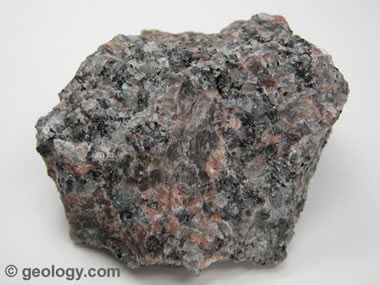
| Granite: The specimen above is a typical granite. It is about two inches (five centimeters) across. The grain size is coarse enough to allow recognition of the major minerals. The pink grains are orthoclase feldspar and the clear to smoky grains are quartz or muscovite. The black grains can be biotite or hornblende. Numerous other minerals can be present in granite. |
The Best-Known Igneous Rock
Granite is the best-known igneous rock. Many people recognize granite because it is the most common igneous rock found at Earth's surface and because granite is used to make many objects that we encounter in daily life. These include counter tops, floor tiles, paving stone, curbing, stair treads, building veneer and cemetery monuments. Granite is used all around us - expecially if you live in a city.
Granite is also well-known from its many world-famous natural exposures. These include: Stone Mountain, Georgia; Yosemite Valley, California, Mount Rushmore, South Dakota; Pike's Peak, Colorado; and White Mountains, New Hampshire.
Multiple Definitions of Granite
The word “granite” is used in a variety of ways by different people. A simple definition is used in introductory courses; a more precise definition is used by petrologists (geologists who specialize in the study of rocks); and, the definition of granite expands wildly when used by people who sell decorative stone such as countertops, tile and building veneer.
These multiple definitions of granite can lead to communication problems. However, if you know who is using the word and who they are communicating with, you can interpret the word in its proper context. Three common usages of the word “granite” are explained below.
A) Introductory Course Definition
Granite is a coarse-grained, light-colored igneous rock composed mainly of feldspars and quartz with minor amounts of mica and amphibole minerals. This simple definition enables students to easily identify the rock based upon a visual inspection.
B) Petrologist's Definition
A plutonic rock in which quartz makes up between 10 and 50 percent of the felsic components and alkali feldspar accounts for 65 to 90 percent of the total feldspar content. Applying this definition requires the mineral identification and quantification abilities of a competent geologist.
Many rocks identified as “granite” using the introductory course definition will not be called “granite” by the petrologist - they might instead be alkali granites, granodiorites, pegmatites or aplites. A petrologist might call these “granitoid rocks” rather than granites. There are other definitions of granite based upon mineral composition.
The chart at right illustrates the range of granite compositions. From the chart you can see that orthoclase feldspar, quartz, plagioclase feldspar, micas, and amphiboles can each have a range of abundances.
C) Commercial Definition
The word “granite” is used by people who sell and purchase cut stone for structural and decorative use. These "granites" are used to make countertops, floor tiles, curbing, building veneer, monuments and many other products.
In the commercial stone industry a “granite” is a rock with visible grains that is harder than a marble. Under this definition gabbro, basalt, pegmatite, schist, gneiss, syenite, monzonite, anorthosite, grannodiorite, diabase, diorite and many other rocks will be called “granite”. The collection of images at right illustrates the range of rocks that might be called "granite".
Uses of Granite
Granite has been used for thousands of years in both interior and exterior applications. Rough-cut and polished granite is used in buildings, bridges, paving, monuments and many other exterior projects. Indoors, polished granite slabs and tiles are used in countertops, tile floors, stair treads and many other practical and decorative features.
High price often reduces the popularity of a construction material and granite often costs significantly more than man-made materials in most projects. However, granite is frequenly selected because it is a prestige material, used in projects to produce impressions of elegance, durability and lasting quality.
Most of the granite produced in the United States comes from high quality deposits in five states: Massachusetts, Georgia, New Hampshire, South Dakota and Idaho.
Granite in the Continental Crust
Most introductory geology textbooks report that granite is the most abundant rock in the continental crust. At the surface granite is exposed in the cores of many mountain ranges, within large areas known as "batholiths," and in the core areas of continents known as "shields."
The large mineral crystals in granite are evidence that it cooled slowly from molten rock material. That slow cooling had to have occurred beneath Earth's surface and required a long period of time to occur. If they are today exposed at the surface the only way that could happen is if the granite rocks were uplifted and the overlying sedimentary rocks were eroded.
In areas where Earth's surface is covered with sedimentary rocks, granites, metamorphosed granites or closely related rocks are usually present beneath the sedimentary cover. These deep granites are known as "basement rocks".

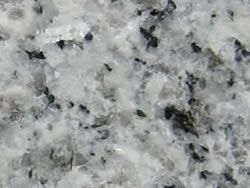

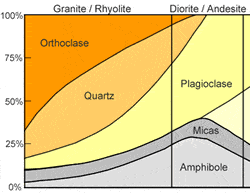
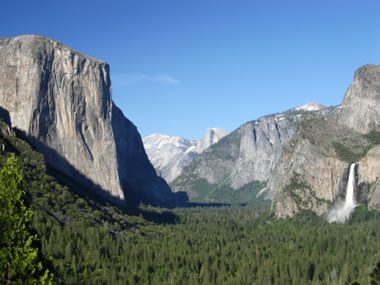




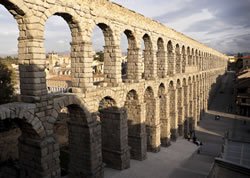

No comments:
Post a Comment